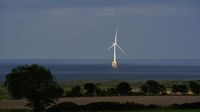Electricity bills are climbing across the United States, outpacing inflation and sparking a fierce debate over what—and who—is to blame. In recent weeks, President Donald Trump has pointed the finger squarely at renewable energy, labeling wind and solar power "THE SCAM OF THE CENTURY!" in a Truth Social post on August 21, 2025. According to the Associated Press, Trump vowed to block new wind and "farmer destroying Solar" projects, declaring, "The days of stupidity are over in the USA!!!"
Yet as the cost of keeping the lights on rises—up more than 5% over the past year, according to federal data cited by TNND—energy analysts and industry experts say the story is far more complex than Trump’s rhetoric suggests. The price hikes, which have been running at more than twice the rate of inflation, are being driven by a stew of factors: surging electricity demand, aging infrastructure, and the mounting toll of extreme weather events worsened by climate change.
At the heart of the debate is a fundamental question: Are renewables really to blame for Americans’ ballooning power bills?
Trump and his administration have been unwavering in their criticism. In July, while visiting Scotland, Trump called wind "the most expensive form of energy" and accused turbines of "destroying the beauty of your fields and your plains and your waterways," according to TNND. Interior Secretary Doug Burgum echoed those concerns, telling The National News Desk that wind and solar are "intermittent" and "not reliable." Burgum also touted the administration’s push to expand coal production, noting new mining permits in Montana, Wyoming, and Utah as a return to "traditional energy development."
Energy Secretary Chris Wright, in an interview with the Washington Examiner on August 22, 2025, backed Trump’s assertions, saying, "The President’s comments are correct, but the situation is more complicated than that." Wright explained that while some states with large renewable energy portfolios have seen price hikes, others—like Iowa and Oklahoma—have managed to keep increases low by maintaining fossil fuel plants alongside new wind and solar projects. "They generate [wind energy] in those states, but most of it isn’t consumed in those states. They have land. They’re pro-development. They do generate power, and they sell it. They sell it onto the whole grid, not just in their own state," Wright said.
But the Trump administration’s critics, including many Democrats and renewable energy advocates, say the president’s focus on wind and solar is misguided. According to the Associated Press, energy analysts point instead to increased demand from cloud computing and artificial intelligence data centers, which require vast amounts of power for servers and cooling systems. The growing popularity of electric vehicles has also contributed to demand, even as Trump and congressional Republicans have moved to restrict tax credits and other incentives for EV purchases.
Natural gas prices have surged as well, with over 40% of U.S. electricity now generated from the fuel. Increased exports to Europe and other international buyers have pushed prices higher, further straining the grid. The Associated Press notes that these factors—rather than renewables—are the main culprits behind the recent cost spikes.
Still, the political battle lines are sharply drawn. Trump campaigned in 2024 on a promise to slash Americans’ electric bills by 50%, but prices have continued to climb. Democrats have been quick to blame the administration’s policies, particularly a recent tax-and-spending cut bill that rolled back clean energy incentives. New Mexico Senator Martin Heinrich, the top Democrat on the Senate Energy and Natural Resources Committee, argued, "Now more than ever, we need more energy, not less, to meet our increased energy demand and power our grid. Instead of increasing our energy supply Donald Trump is taking a sledgehammer to the clean energy sector, killing jobs and projects."
Heinrich and other critics point to a report from Energy Innovation, a non-partisan think tank, which found that the GOP tax law will increase the average family’s energy bill by $130 annually by 2030. The law, the report says, "significantly hampers the development of domestic electricity generation capacity" by phasing out technology-neutral clean energy tax credits and adding complex material sourcing requirements.
Industry groups have been even more blunt. The Solar Energy Industries Association responded to Trump’s post by stating, "The real scam is blaming solar for fossil fuel price spikes. Farmers, families, and businesses choose solar to save money, preserve land, and escape high costs of the old, dirty fuels being forced on them by this administration." Jason Grumet, CEO of the American Clean Power Association, told the Washington Examiner, "The only significant source of electricity that can be added to the grid during the Trump administration are renewable resources." He added, "Blocking cheap, clean energy while doubling down on outdated fossil fuels makes no economic or environmental sense."
According to Grumet, over 90% of new energy capacity that came online in the U.S. in 2024 was clean energy. Ted Kelly, director of U.S. clean energy for the Environmental Defense Fund, echoed that sentiment, arguing that wind and solar are among the cheapest and fastest ways to provide electric power.
Yet, the administration’s stance remains firm. Wright emphasized the intermittency of wind and solar, claiming that without adequate battery technology, such infrastructure is "worthless" when it’s dark or the wind isn’t blowing. "As you deploy more renewables, you’re basically building a whole separate grid," he said. "If you take a grid or a system and grow the renewables penetration, you will raise the price of it. The president’s 100% correct in that."
The debate is not confined to partisan lines. Iowa Senator Chuck Grassley, a Republican and a longtime supporter of wind power, has advocated for a gradual phase-out of tax credits for wind and solar rather than an abrupt end. Grassley said he was encouraged by new Treasury guidance that limits, but does not eliminate, such credits. "The guidance seems to offer a viable path forward for the wind and solar industries to continue to meet increased energy demand," he said.
Meanwhile, the Trump White House announced a trade investigation into imported wind turbines on August 21, 2025, a move that could lead to tariffs and raise costs for offshore wind projects reliant on foreign parts, according to TNND. Clean energy supporters warn that these actions, combined with regulatory roadblocks, could slow the expansion of renewables and eliminate as many as 45,000 jobs by 2030, as John Quigley of the Kleinman Center for Energy Policy told the Associated Press.
Amid the finger-pointing, some facts are clear: electricity prices have risen 5.5% year-over-year as of July 2025, and projections suggest the trend will continue into 2026. States with high levels of wind generation, including Iowa, Kansas, and Oklahoma, have seen prices rise more slowly than the national average, offering a counterpoint to claims that renewables drive up costs. As the battle over America’s energy future rages on, the stakes—for consumers, workers, and the climate—could hardly be higher.
With the grid under unprecedented strain and the nation’s energy mix in flux, the debate over what’s powering America’s rising bills is set to intensify in the months ahead.

